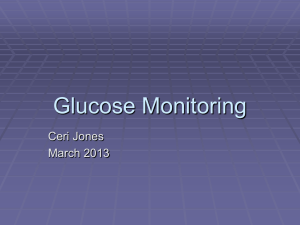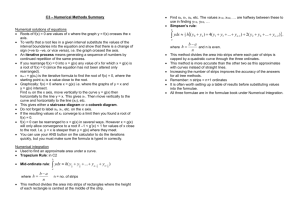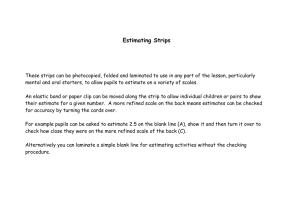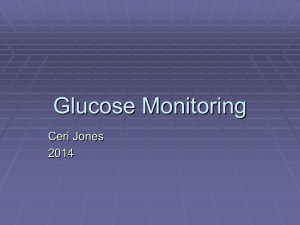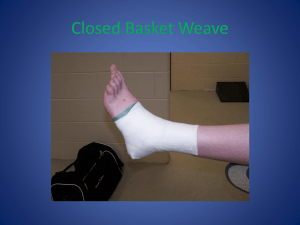ð Other - BioMed Central
advertisement
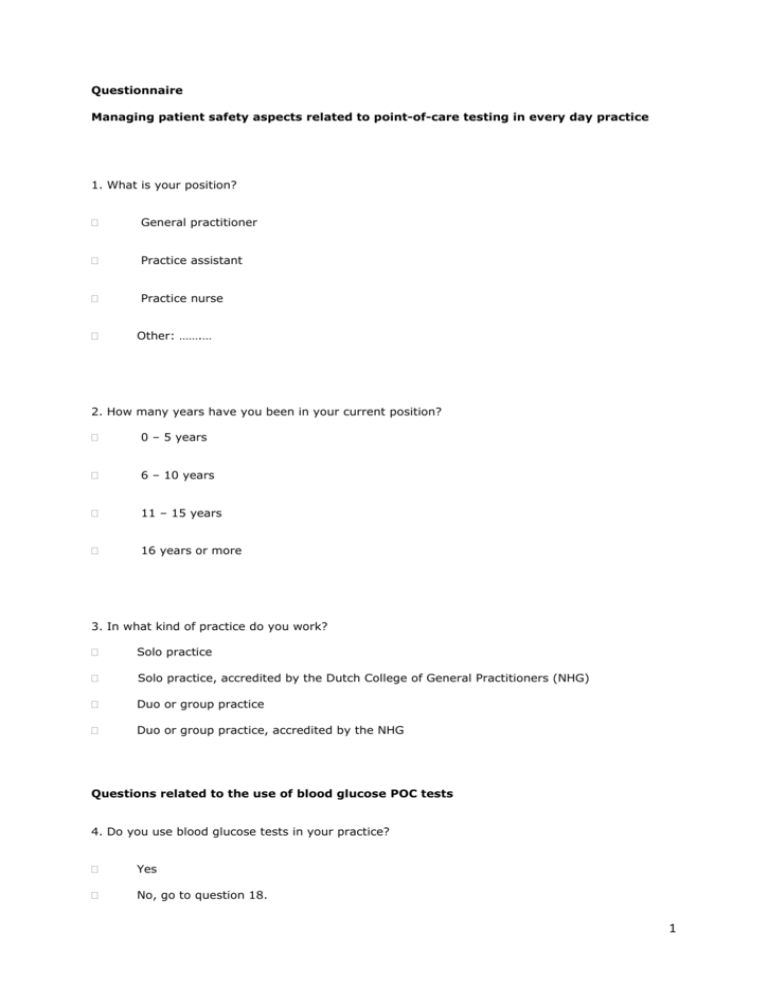
Questionnaire Managing patient safety aspects related to point-of-care testing in every day practice 1. What is your position? General practitioner Practice assistant Practice nurse Other: …….… 2. How many years have you been in your current position? 0 – 5 years 6 – 10 years 11 – 15 years 16 years or more 3. In what kind of practice do you work? Solo practice Solo practice, accredited by the Dutch College of General Practitioners (NHG) Duo or group practice Duo or group practice, accredited by the NHG Questions related to the use of blood glucose POC tests 4. Do you use blood glucose tests in your practice? Yes No, go to question 18. 1 5. Since when are blood glucose tests used in your practice? Since |__|__||__|__||__|__||__|__| (ddmmyyyy) 6. How often do you use a blood glucose test in your practice? Daily Weekly Monthly Yearly 7. Is there a test procedure for the blood glucose tests, which has been written specifically for your practice? Yes No 8. Who gives instruction to the employees on how to use the blood glucose tests? General practitioner Manufacturer Practice assistant Practice nurse No instructions are given (go to question 10) Other:………………………. 2 9. Is the instruction completed with an exam? Yes, we register who have passed the exam Yes, however we do not register who have passed the exam No 10. Do you organize refresher courses for the use of the blood glucose test? Yes, …… times a year Yes, only if the tests or instructions for use were changed No Other:………………………. 11. Which control measures do you take when receiving new blood glucose test materials? (Multiple answers are possible) Check the expiry data of test strips Check storage conditions of test strips (e.g. temperature of storage space) Completeness of the test equipment Check if the codes of the meter and test strips correspond Check if the sealing of the test strips is undamaged None of the above, I may assume that the POC test materials are of good quality Other:…….. 12. Which preparations do you take before performing a blood glucose test? (Multiple answers are possible) Give instruction to the patient (e.g. dietary advice) 3 Check expiry date of test strips Check storage conditions of test strips (e.g. temperature of storage location) Check latest moment of calibration Check latest moment of maintenance Check if test strips are clean and undamaged Completeness of the test equipment Read the instructions for use Read the test procedure, written specifically for our practice Other:…….. 13. Which aspect(s) do you consider when taking a blood sample from a finger prick and performing the test? (Multiple answers are possible) Patient identification Washing your hands Wearing gloves Use of disinfectant Washing the finger of the patient Disinfecting the finger of the patient Removing first drop of blood Preventing pushing blood from the finger Filling the test area of the test strip completely Other:…….. 14. How do you record the test results? (Multiple answers are possible) Manually, in the paper dossier of the patient Manually, on a specific paper form for test results 4 Manually, in an electronic health record (EHR) system Manually, as free text on the E and/or P rules of the S,O, E or P rules* of the EHR system Automatically, via an electronic link between device and registry system Test results are not recorded I do not know * S- subjective: reason for contact, O-objective: physical exam, E- evaluation: diagnose, Ptreatment plan 15. Which action(s) do you take when the blood glucose meter shows an error? (Multiple answers are possible) I never get errors Repeat the test Check whether the test area of the test strip is completely filled with blood Check whether the test strip is inserted correctly into the meter Check the meter (e.g. battery) Check expiry date of the test strips Contact the manufacturer of the test Use another meter Refer the patient to a laboratory Collect a blood sample via venipuncture and send the sample to a laboratory I do not take actions Other:…….. 5 16. Which action(s) do you take when test results conflict with the symptoms? (Multiple answers are possible Check the meter (e.g. battery) Repeat the test Use another meter Collect a blood sample via venipuncture and send the sample to a laboratory Refer the patient to a laboratory Refer the patient to a specialist Life style advice (e.g. diet) Prescribe or adjust medication I do not take actions Other:…….. 17. Which test results and symptoms lead to action? (Multiple answers are possible Glucose levels high, no symptoms Glucose levels high, symptoms Glucose levels normal, no symptoms Glucose levels normal, symptoms Glucose levels low, no symptoms Glucose levels low, symptoms I do not know 6 7 Questions related to the use of Nitrite POC tests 18. Do you use nitrite tests in your practice? Yes No, go to question 33 19. Since when are nitrite tests used in your practice? Since |__|__|__|__|__|__|__|__| (ddmmyyyy) 20. How often do you use a nitrite test in your practice? Daily Weekly Monthly Yearly 21. Is there a test procedure for the nitrite tests written specifically for your practice? Yes No 22. Who gives instruction to the employees on how to use the nitrite tests? General practitioner Manufacturer Practice assistant Practice nurse No instruction is given (go to question 24) Other:………………………. 8 23. Is the instruction completed with an exam? Yes, we register who have passed the exam Yes, however we do not register who have passed the exam No 24. Do you organize refresher courses for the use of the nitrite test? Yes, …… times a year Yes, only if the tests or instructions for use are changed No Other: 25. Which control measures do you take when receiving the new nitrite test materials? (Multiple answers are possible) Check the expiry data of test strips Check storage conditions of test strips (e.g. temperature of storage location) Check if the sealing of the test strips is undamaged None of the above, I may assume that the POC test materials are of good quality Other:…….. 9 26. Which preparations do you take before performing a nitrite test? (Multiple answers are possible) Give instruction to the patient (e.g. on how to collect a urine sample) Check expiry date of test strips Check storage conditions of test strips Check if test strips are clean and undamaged Read the instructions for use Read test procedure written specifically for our practice Other,…….. 27. What kinds of urine samples do you accept when a patient brings his/her urine sample from home? (Multiple answers are possible) First morning urine samples First morning samples that are collected at a maximum of two hours before actual testing. All types of urine samples I do not know Other,…….. 28. Which aspect(s) do you consider when performing a Nitrite test? (Multiple answers are possible) Patient identification Other,…….. 29. How do you record the test results? (Multiple answers are possible) 10 Manually, in the paper dossier of the patient Manually, on a specific paper form for test results Manually, in the Netherlands information Network of General Practice (LINH) database Manually, as free text on the E and/or P rules of the S,O, E or P rules* of the LINH database Automatically, via an electronic link between device and registry system Test results are not recorded I do not know * S- subjective: reason for contact, O-objective: physical exam, E- evaluation: diagnose, Ptreatment plan 30. Which action(s) do you take when the nitrite test strip is unreadable (device failure)? (Multiple answers are possible) Test strips are always readable Repeat the test with the same urine sample Check the storage condition of the test strips Check expiry date of the test strips Collect new urine sample Use another batch of test strips Contact the manufacturer of the test Refer a patient to a specialist Refer a patient to a laboratory Send the sample to a laboratory I do not take actions Other:…….. 11 12 31. Which action(s) do you take when test results conflict with the symptoms? (Multiple answers are possible) Check urine sample with other point-of-care test Test urine sample with dip slide test Send the urine sample to a laboratory Collect new urine sample Refer the patient to a laboratory Life style advice Prescribe antibiotics Other:…….. 32. Which action(s) do you take when test results point toward a urinary tract infection? (Multiple answers are possible) Test the urine sample with another point-of-care test Test the urine sample with a dip slide test Send the urine sample to a laboratory Collect new urine sample Refer the patient to a laboratory Life style advice Prescribe antibiotics Other:…….. Questions related to the use of haemoglobin POC tests 13 33. Do you use haemoglobin tests in your practice? Yes No. 34. Since when are haemoglobin tests being used in your practice? Since |__|__|__|__|__|__|__|__| (ddmmyyyy) 35. How often do you use a haemoglobin tests in your practice? Daily Weekly Monthly Yearly 36. Is there a test procedure for the haemoglobin tests written specifically for your practice? Yes No 37. Who gives instruction to the employees on how to use the haemoglobin tests? General practitioner Manufacturer Practice assistant Practice nurse No instructions are given (go to question 10) Other:………………………. 38. Is the instruction completed with an exam? 14 Yes, we register who have passed the exam Yes, however we do not register who have passed the exam No 39. Do you organize refresher courses for the use of the haemoglobin test? Yes, …… times a year Yes, only if the tests or instructions for use were changed No Other:………………………. 40. Which control measures do you take when receiving new haemoglobin test materials? (Multiple answers are possible) Check the expiry date of test strips Check storage conditions of test strips (e.g. temperature of storage location) Completeness of the test equipment Check if the codes of the meter and test strips correspond Check if the sealing of the test strips is undamaged None of the above, I may assume that the POC test materials are of good quality Other:…….. 41. Which preparations do you take before performing a haemoglobin test? (Multiple answers are possible) Give instruction to the patient (e.g. dietary advice) Check expiry date of test strips Check storage conditions of test strips (e.g. temperature of storage location) 15 Check latest moment of calibration Check latest moment of maintenance Check if test strips are clean and undamaged Check completeness of the test equipment Read the instruction for use Read test procedure, written specifically for our practice Other:…….. 42. Which aspect(s) do you consider when taking a blood sample from a finger prick and performing the test? (Multiple answers are possible) Patient identification Washing your hands Wearing gloves Use of disinfectant Washing the finger of the patient Disinfecting the finger of the patient Removing first drop of blood Preventing pushing blood from the finger Filling the test area of the test strip completely Other:…….. 16 43. How do you record the test results? (Multiple answers are possible) Manually, in the paper dossier of the patient Manually, on a specific paper form for test results Manually, in the Netherlands information Network of General Practice (LINH) database Manually, as free text on the E and/or P rules of the S,O, E or P rules* of the LINH database Automatically, via an electronic link between device and registry system Test results are not recorded I do not know * S- subjective: reason for contact, O-objective: physical exam, E- evaluation: diagnose, Ptreatment plan 44. Which action do you take when the haemoglobin meter shows an error? (Multiple answers are possible) I never get errors Repeat the test Check whether the test area of the test strip is completely filled with blood Check whether the test strip is inserted correctly into the meter Check the meter (e.g. battery) Check expiry date of the test strips Contact the manufacturer of the test Use another meter Refer the patient to a laboratory 17 Collect a blood sample via venipuncture and send the sample to a laboratory I do not take actions Other:…….. 45. Which action do you take when test results show abnormal results? (Multiple answers are possible Check the meter Repeat the test Use another meter Collect a blood sample via venipuncture and send the sample to a laboratory Refer the patient to a laboratory Refer the patient to a specialist Collect a new urine sample Inquire about the patient’s diet Prescribe or adjust medication I do not take actions Other:…….. End of the questionnaire! 18
